- 1Global Forestry Division, Future Forest Strategy Department, National Institute of Forest Science, Seoul, Republic of Korea
- 2OJEong Resilience Institute (OJERI), Korea University, Seoul, Republic of Korea
As one of the efforts to combat climate change and the biodiversity crisis, an interest in nature-based solutions (NbS) has been growing. Although there have been diverse discussions on NbS, it is still insufficient to find a quantitative evaluation of the global research trends in which field and to what extent NbS has been studied. In this regard, this study employed latent Dirichlet allocation (LDA) topic modeling and keyword analysis to quantitatively evaluate the research trends of NbS. Among research papers on NbS searched on SCOPUS, 2,625 studies (2009–2022) were analyzed by LDA. As a result, NbS-related articles were classified into seven topics (i.e., Urban governance, Urban green infrastructure, Wastewater treatment, Coastal protection, Flood mitigation, Carbon sequestration, and Sustainable agriculture). Of these, the urban and water-related topics accounted for the largest proportion. In contrast, the carbon sequestration and sustainable agriculture topics accounted for a smaller proportion, but the proportion significantly increased over time. As a result of keyword analysis, the frequency of urban and water keywords remained high. In contrast, the frequency of climate change and carbon keywords was low and has recently increased. In the keyword network, the co-occurrence frequency and connection of urban and water keywords were initially high. Still, over time, keywords related to climate change and carbon increased similarly to those related to urban and water. The findings of this study imply that NbS has mainly focused on urban and water-related researches. Still, climate change and carbon-related researches may also be actively handled in relation to NbS in the near future.
1 Introduction
Among diverse efforts to combat the climate change and biodiversity crises faced by human beings, attempts to find solutions based on nature have attracted huge attention (Pettorelli et al., 2021). Such attempts are not a new concept and have existed, which can be found in various regions where residents have used nature to solve problems (e.g., Berkes et al., 2000; Albuquerque et al., 2021). However, since the term “nature-based solutions (NbS)” was first coined in World Bank report in 2008 (MacKinnon et al., 2008), there have been more studies using this term, and recently, it has evolved into a political agenda in international communities (Seddon et al., 2020, 2021). For instance, the Intergovernmental Science-Policy Platform on Biodiversity and Ecosystem Services [IPBES] (2019) has introduced NbS as a cost-effective measure to achieve sustainable development goals (SDGs), which are essential for global sustainability. The Intergovernmental Panel on Climate Change [IPCC] (2022) has also accepted with very high confidence that NbS can provide human beings with benefits for climate change mitigation and adaptation, and contribute to achieving other SDGs.
The NbS definition has not yet been agreed upon. Still, the definitions suggested by the International Union for Conservation of Nature [IUCN] (2023) and the European Commission [EC] (2023) are the most frequently utilized. IUCN defined NbS as “actions to protect, sustainably manage, and restore natural or modified ecosystems that address societal challenges effectively and adaptively, simultaneously providing human wellbeing and biodiversity benefits (Cohen-Shacham et al., 2016).” On the other hand, EC defined NbS as “solutions that are inspired and supported by nature, which are cost-effective, simultaneously provide environmental, social and economic benefits and help build resilience. Such solutions bring diverse nature and natural features and processes into cities, landscapes, and seascapes through locally adapted, resource-efficient, and systemic interventions. Nature-based solutions must benefit bio-diversity and support the delivery of ecosystem services (European Commission [EC], 2023).” Such definitions clarified by the two organizations have common features in that they are a method (1) through nature, (2) while solving social issues, and (3) benefiting biodiversity, but they also have different features in how they involve nature. IUCN emphasizes solutions to protect, manage, and restore nature, whereas the EU is aware of a wider range of solutions, encompassing solutions inspired by or supporting nature. The definition by IUCN is more general, while EC’s is more specific regarding scope or applicability (Bianciardi et al., 2023).
Despite the ongoing debate on the definition, the research area of NbS, which attempts to solve social issues based on nature, has already been widely recognized. For example, Pettorelli et al. (2021) indicated that NbS has handled fields that address several interconnected social challenges, such as climate change, water security, human health, disaster risk reduction, and food security. Seddon et al. (2021) recognize a wider range of fields as the scope of NbS: greenhouse gases (GHGs) reduction, flood and erosion control, coastal defense, cooling and shading, food and water security, livelihoods, cultural values, and social capital. International Union for Conservation of Nature [IUCN] (2023) classified NbS topics into agriculture and soil biodiversity, disaster risk reduction, ecosystem restoration, nature-based solutions for climate, and nature-based solutions for cities. In other words, NbS has a broad concept that encompasses a wide range of environmental, social, and economic challenges. As the NbS concept became so widely known, some countries such as Germany have recently adopted the concept and established the national policy framework (Federal Ministry for the Environment, Nature Conservation, Nuclear Safety and Consumer Protection [BMUV], 2023). IUNC has also developed a global standard for NbS to help design, assess, strengthen, and upscale NbS interventions (Le Gouvello et al., 2023).
Under the circumstances where the application range of NbS is wide, it is necessary to specifically understand which fields should be considered NbS, and what kinds of related research are ongoing. However, finding studies covering comprehensive NbS research trends with quantitative approaches is still insufficient. Although there have been several attempts, they have their own significance and limitations. For instance, Su et al. (2023) targeted 176 NbS articles focusing on urban wastewater management, analyzed the research trends in a bibliometric method, and classified research fields into four groups (i.e., green infrastructure, stormwater runoff, climate change mitigation and adaption, and flood risk and biodiversity), but failed covering the entire fields of NbS. Nyika and Dinka (2022) targeted 137 articles covering NbS cases in Africa, and classified them into six areas (i.e., integrated environmental management, water security, health, climate change mitigation and adaption, food security enhancement, and disaster risk reduction) for analysis, but faced limitations in that they only provided region-specific information rather than global trends. On the other hand, Parker et al. (2020) quantitatively reviewed 54 articles with both NbS and climate change in the title, but the number of research papers analyzed is minimal, and representativeness should be more secure; to this end, a time-efficient and quantitative approach is required to analyze a large number of research papers. As part of this attempt, Castellanos et al. (2020) attempted to analyze the research trends of NbS applied to urban areas in Europe via a text mining technique. However, they could not cover the entire field; they only focused on three review reports. Recently, Choi et al. (2023) tried to analyze the research trend on the entire field of NbS using dynamic topic modeling; however, it focused on only topic level not on keyword level. Consequently, there is a need for an efficient and quantitative analysis of the comprehensive research trends of NbS, which is rapidly growing worldwide.
Under the circumstances, this study aims to answer the question: “How have the global research trends in NbS changed?” To answer this question, this study utilized latent Dirichlet allocation (LDA) topic modeling analysis and keyword analysis that help researchers quantitatively analyze research trends. Additionally, it targeted NbS-related articles published from 2009, after 2008, when NbS was first officially utilized, to 2022, and analyzed NbS research trends. By identifying changes in NbS research trends, this study attempted to provide meaningful insights into what kinds of research have received attention and what sorts of research are likely to be handled more in the near future. The findings of this study will provide scientists, policymakers, and the general public unfamiliar with the NbS concept, with a comprehensive picture to help them easily understand NbS.
2 Materials and methods
Figure 1 is an overall diagram of the research method, consisting of data collection, data pre-processing, LDA topic modeling, and keyword analysis.

Figure 1. Diagram of the research method to investigate changes in research trends of nature-based solutions.
2.1 Data collection
Figure 2 shows the data collection and filtering phase. This study set the research period from 2009, after 2008, when the NbS term was first formulated, to 2022. The titles and abstracts of 2,902 articles in English were collected from SCOPUS, an academic journal search website, for which “nature-based solution” was found in the title, abstract, and index keywords. The analysis excluded six duplicates and 78 articles for which no abstract was provided. On the one hand, since “nature-based solutions” is a compound term, words such as “nature,” “based,” and “solution” were used separately, but articles unrelated to NbS were also included. On the other hand, there were several research papers belonging to NbS, even though only “nature-based” was used, and the following other terms other than “solution” (e.g., climate solution, cooling, infrastructure, management, health solution, and social welfare) were utilized during the search. Thus, two researchers independently reviewed the research papers. They included several articles in the analysis if they contained the compound term “nature-based solution” in the title, abstract, or index keywords. After reading the abstracts of the remaining papers, they filtered and excluded papers unrelated to NbS. The filtering criteria were based on the NBS definitions suggested by IUCN and EC definitions: (1) Does the method use nature, (2) Can it solve social issues? And does it bring (3) benefits to biodiversity, ecosystem services, and human welfare/wellbeing? The 193 research papers that do not meet any of these criteria were excluded. As a result, a total of 2,625 articles were utilized for analysis.
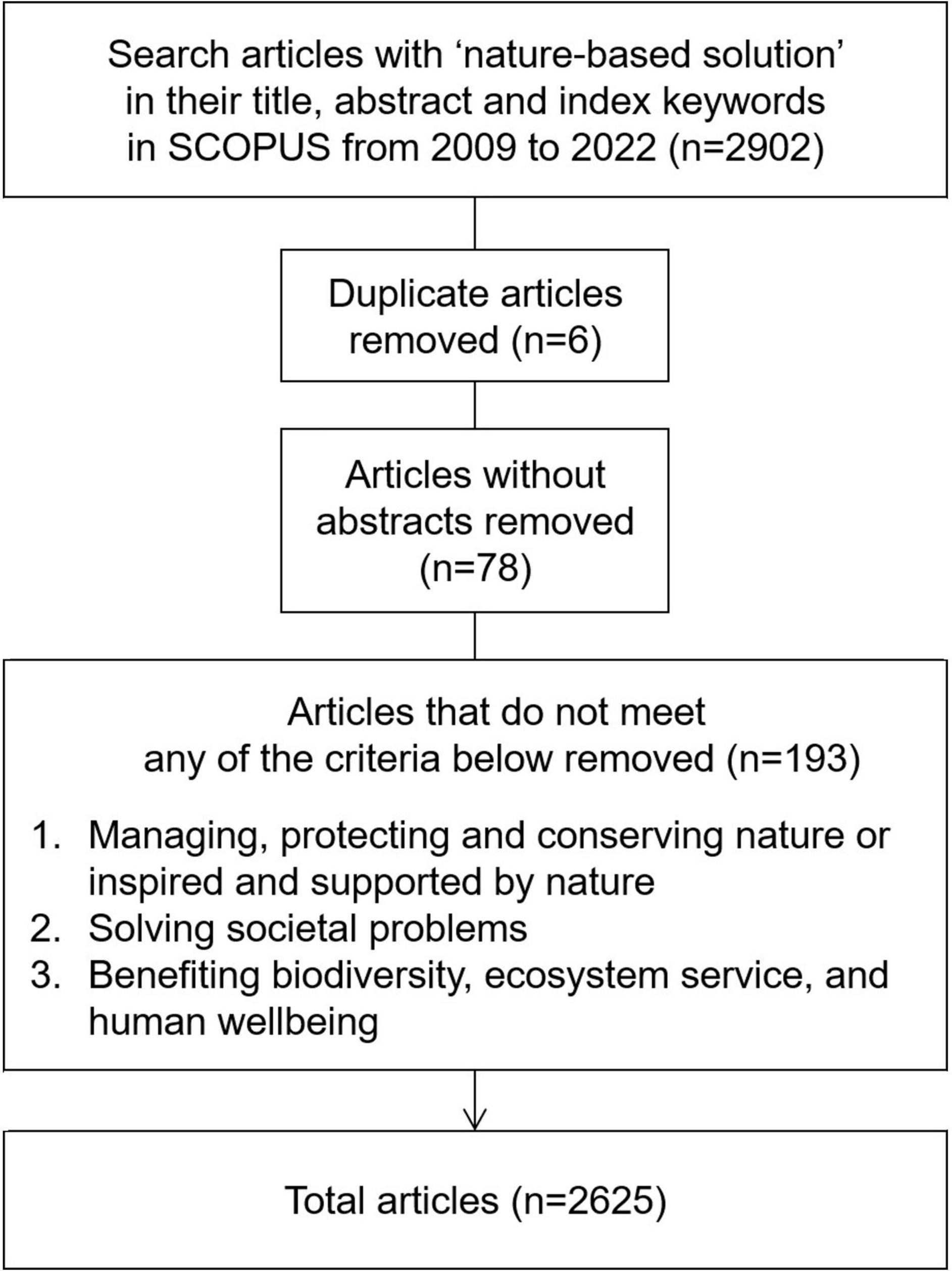
Figure 2. Data collection and filtering to investigate changes in research trends of nature-based solutions.
2.2 Data pre-processing
To pre-process the collected data, tokenization was performed via Python, which divides text data into tokens, the smallest unit of meaning. Since all tokenized words are not meaningful, stopwords in English, special symbols, and punctuation marks provided by the Natural Language Toolkit of Python (3.11.4 ver.) were removed. Each token was tagged with a part of speech, such as a noun, adjective, verb, or adverb, and then lemmatization tagging was performed to extract only nouns and adjectives. Nouns and adjectives frequently utilized in all articles were eliminated (Supplementary Table 1). Additionally, words with less than two syllables were removed, lowercase conversion was performed on all words, and singular and plural words were treated equally.
2.3 Latent Dirichlet allocation topic modeling
Topic modeling is a text mining technique that helps find hidden semantics in a set of documents and classify them into topics; LDA is the most frequently utilized tool among the various topic modeling tools. This method recognizes text data as three structures – documents, words, and topics. It assigns each document and word to a specific topic based on Dirichlet prior distribution. A detailed theoretical description of LDA can be found in Kherwa and Bansal (2019) or Vayansky and Kumar (2020).
Hyperparameters were adjusted to select the optimal number of topics at the topic modeling phase. The number of topics is the crucial hyperparameter in LDA. If an insufficient number of topics is selected, the content of a topic is too broad, while if too many topics are selected, small and similar topics are created. There are numerous ways to determine the number of topics in topic modeling (Kherwa and Bansal, 2019), but this study selected the number of topics based on the coherence score, which is a frequently used criterion (Chang et al., 2009; Greene and Cross, 2017; Yao and Wang, 2020). The coherence score is an indicator of measuring the consistency of the keywords that comprise a topic; a higher coherence score indicates the keywords better describe the topic (Röder et al., 2015). To determine the number of topics for LDA, modeling was conducted several times with different combinations of passes and iterations, and seven topics with the highest coherence score of 0.050 (passes = 50, iteration = 320; Figure 3) were selected.
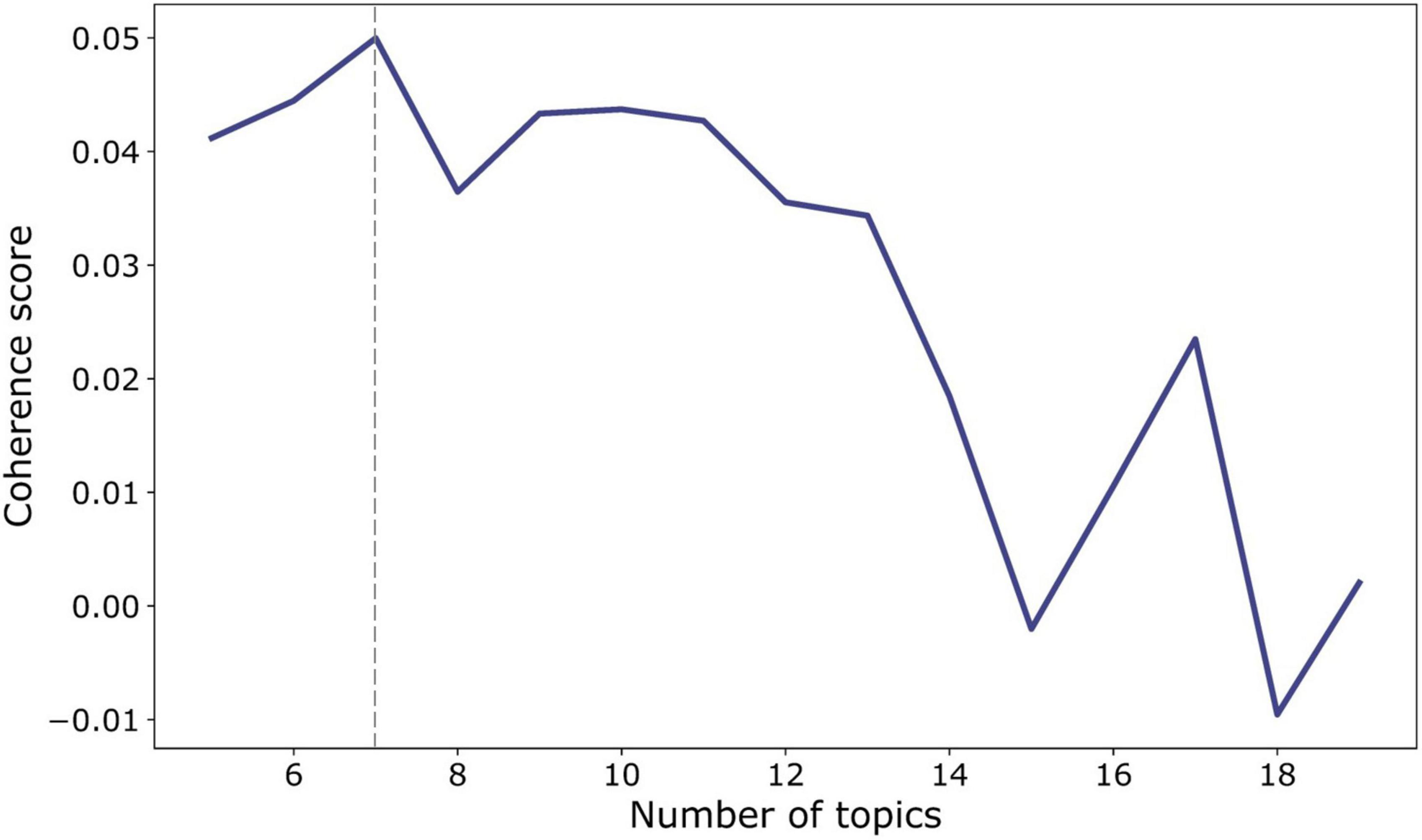
Figure 3. Coherence score of latent Dirichlet allocation (LDA) topic modeling depends on the number of topics. The highest coherence score was observed for seven topics.
This study targeted all data collected from 2009 to 2022 and performed an LDA topic modeling analysis through Python’s “Gensim” library. Although the model assigns each article to a topic, the content must be interpreted by researchers. Considering that two researchers interpreted the topics based on the top 20 keywords with the highest probability of being assigned to each topic and 10 representative articles (Supplementary Table 2). The interpretation of the topics was reviewed and revised by all co-authors. Next, a linear regression analysis with the Python “statsmodel” library was performed to test the significance of trends over time in the number of articles of each topic (i.e., topic frequency) and the proportion of articles in each topic among the total number of articles (i.e., topic proportion). The independent variable was set as the year of publication, and the dependent variables were set as topic frequency and proportion. The significance level was set at 95%. If the regression coefficient is positive, the topic is a hot topic (i.e., significantly increased by time). If it is negative, it is a cold topic (i.e., significantly decreased by time).
2.4 Keyword analysis
Simple frequency analysis of keywords analyzes how frequently a keyword is used in articles published during a certain period. To identify changes in the frequency of keywords comprising NbS research, this study divided the period since 2017, when the number of articles was assumed to be sufficient because more than 70 research papers were annually published, into three periods of 2 years each (i.e., 2017–2018, 2019–2020, and 2021–2022), and compared the changes per period. During this period (2017–2022), more than 97% of all research papers were published.
Keyword network analysis is a methodology that extracts meaningful keywords from a text and creates a network by figuring out connections between keywords playing a core role (Lee, 2014). Through network analysis, relationships between keywords are expressed with nodes and links. In this study, the size of nodes was set as the centrality value of keywords, and the thickness of links was set as the co-occurrence frequency of keyword pairs. Here, centrality refers to “the degree to which a particular node is centrally located with intensive connections.” This study employed two types of centralities (i.e., degree centrality and betweenness centrality); degree centrality has a higher value when the number of links that are linked to a particular node increases, and betweenness centrality has a higher value when a particular node links with the shortest distance (i.e., fewer links) between two other nodes (Yu and Lee, 2008; Yan and Ding, 2009). For each period, the top 20 keywords were selected as nodes in order of higher centrality values. The link connecting the corresponding pair was expressed in bold when the higher co-occurrence frequency of a specific keyword pair appears, since the higher co-occurrence frequency means the higher connection between keywords simultaneously found in a document (Cambrosio et al., 1993; Ding et al., 2001). After the keyword network analysis using the “networkx” library in Python, the changes in the keyword network were compared between the three periods.
3 Results
3.1 Latent Dirichlet allocation topic modeling
3.1.1 Overall papers
Figure 4 indicates the number of NbS-related articles searched on SCOPUS from 2009 to 2022. From 2009 to 2016, only 1–36 articles (less than 3% of all research papers) were annually published, but from 2017, more than 70 research papers were annually published. The number rapidly increased, reaching 1,008 research papers published (38% of the research papers) in 2022.
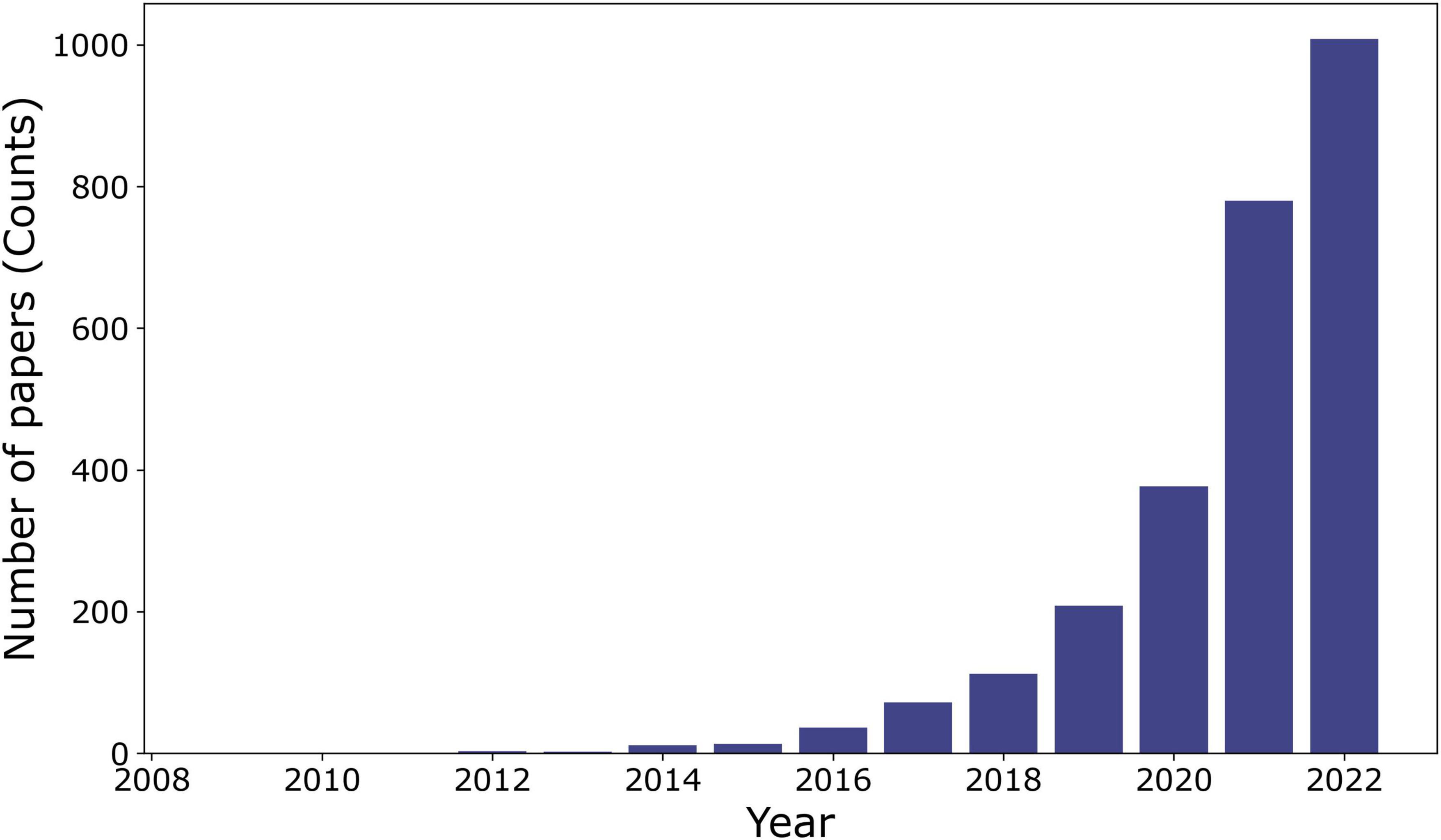
Figure 4. Number of papers published from 2009 to 2022 that were identified using the keyword “nature-based solution” on SCOPUS.
3.1.2 Topic interpretation
Based on the LDA topic modeling results, NbS research was classified into seven topics (Table 1). The keywords were presented in descending order in Table 1 in the order of the highest probability of being assigned to each topic. In other words, the higher the ranking, the more important the keyword in the corresponding topic was. The name and interpretation of the topic were determined based on the top 20 keywords and 10 representative research papers.
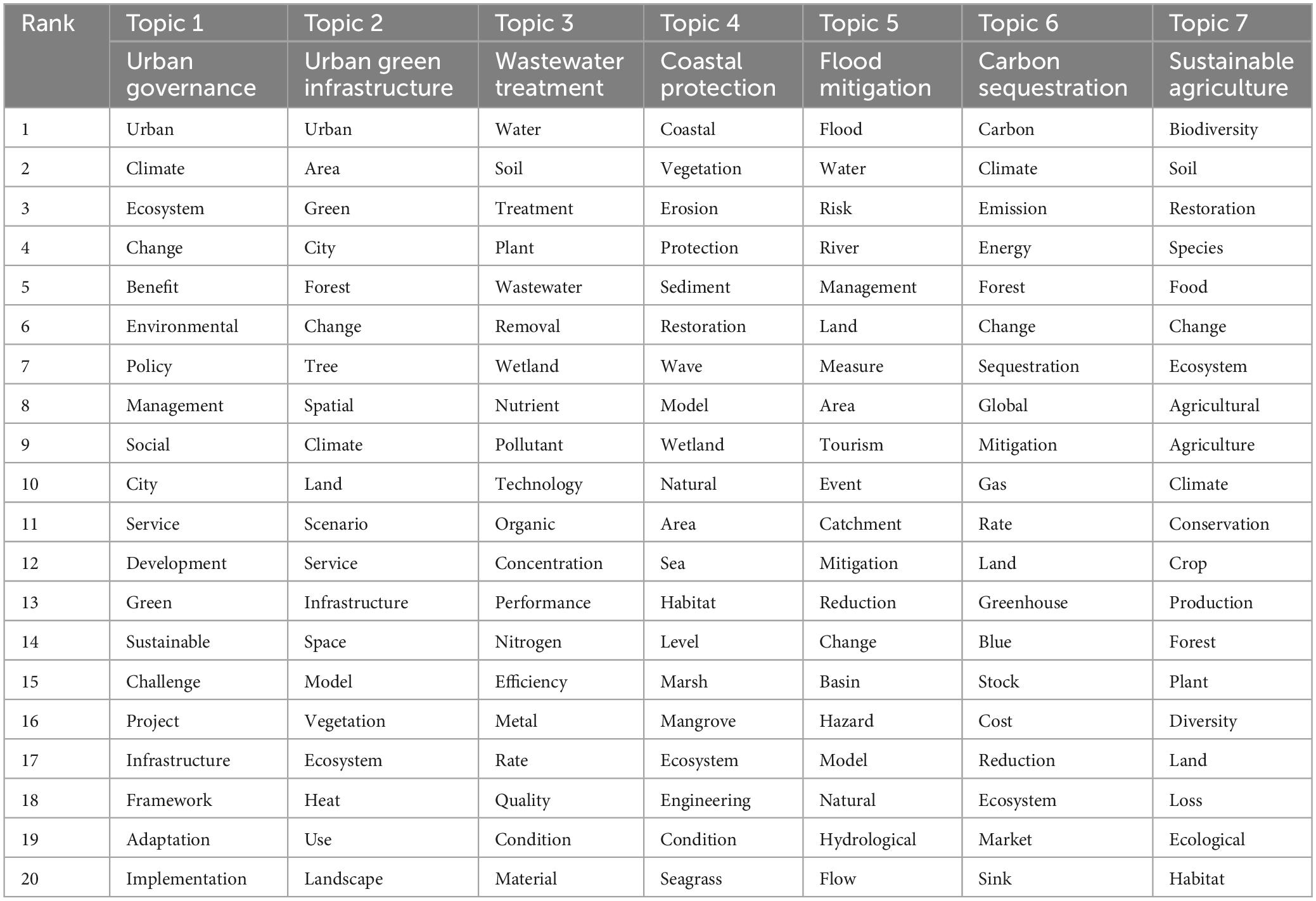
Table 1. The top 20 keywords of topics classified by latent Dirichlet allocation (LDA) topic modeling for the research on nature-based solutions from 2009 to 2022.
The topics can be interpreted as follows. Topic 1 is “Urban governance.” The articles on this topic handle people’s perception and participation surveys, governance, policies, conceptual frameworks, and societal paradigms needed to solve diverse urban issues (e.g., climate change, water scarcity, and wastewater treatment) through NbS. Here, NbS is recognized as a catalyst for urban regeneration strategies that promote climate resilience via nature, improve the wellbeing and health of citizens, and restore neighborhood belonging (e.g., Mahmoud et al., 2021; Hardoy et al., 2022; Wamsler et al., 2023). There is less focus on specific technologies or engineering applications for implementing NbS but more on conceptual frameworks, values and norms, and policy directions for transitioning and evaluating systems (e.g., Beceiro et al., 2020; Gunn et al., 2021).
Topic 2 is “Urban green infrastructure.” The articles on this topic focus on nature-based infrastructure that can contribute to handling urban microclimate-related issues. For example, to mitigate heat islands, where temperatures in cities are significantly higher than those in surrounding areas, green infrastructure utilizing plants or blue infrastructure utilizing water (e.g., rooftop gardens, open green spaces, and waterfront parks) have been suggested as nature-based solutions. There have been empirical studies to primarily demonstrate the heat island mitigation effectiveness through spatial mapping of these green-blue infrastructures, analysis of their relationship with land surface temperature, and model scenarios (e.g., Nastran et al., 2019; Alves et al., 2022; Du et al., 2022). Other examples encompass research on the role of urban street trees or land cover in regulating urban surface runoff (e.g., Zabret and Šraj, 2019; Xu et al., 2020). In contrast to Topic 1, Topic 2 primarily focuses on quantitative validation of the problem-solving effectiveness of physical urban infrastructures based on plants or water.
Topic 3 is “Wastewater treatment.” The articles on this topic cover wastewater or greywater purification methods using specific plant species, biofilters of plants or microorganisms, or constructed wetlands. These contaminated waters have pollutants such as heavy metals and feces and excessive amounts of nutrients, such as phosphorus and nitrogen. The articles on this topic primarily focused on filtering such pollutants based on nature (e.g., Barron et al., 2020; Arslan and El-Din, 2021; Montenegro et al., 2021; Cavazzoli et al., 2022).
Topic 4 is “Coastal protection.” The articles belonging to this topic chiefly handle nature-based solutions to mitigate erosion or impacts from waves on seashores. As a representative example, such articles focus on how effectively waves can be mitigated through such methods as seagrass meadows, salt marshes, mangrove forests, oyster breakwater reefs, and sand trapping fences for coastal dunes while aiming to protect the coast from erosion (e.g., Chowdhury et al., 2019; Eichmanns and Schüttrumpf, 2020; James et al., 2020; van Veelen et al., 2021; Zhao and Nepf, 2021; Zhu et al., 2022).
Topic 5 is “Flood mitigation.” Articles on this topic address nature-based solutions to prevent or mitigate floods, which have become more frequent in recent years due to climate change, urbanization, and land use change. Representative solutions suggested encompass various types of wetlands, detention ponds, flood-peak polders, and tree planting that can store and slow down flash flood waters and be cost-effective measures to buffer flood damage and improve the resilience of nature, compared to engineering solutions (e.g., Bokhove et al., 2019; Wu et al., 2020, 2022; Tseng et al., 2022; Ungvári and Kis, 2022).
Topic 6 is “Carbon sequestration.” Articles on this topic deal with nature-based solutions for mitigating carbon dioxide (CO2), the primary GHGs causing climate change. Forest restoration or reforestation has been suggested as the most effective means to capture and store CO2 in the air; while targeting primary forest, secondary forest, and urban forest, there have been studies with a more focus on monitoring and predicting changes in carbon storage based on the current carbon storage, and the deforestation and reforestation (e.g., Reynolds et al., 2017; Fuller and Dwivedi, 2021; Elias et al., 2022; Matthews et al., 2022). Additionally, the following measures have been discussed as important nature-based solutions to sequester and store carbon: restoring peatlands, which have accumulations of peat created by the partial decomposition of plant organic matter under waterlogged conditions, or creating seagrass in the ocean (e.g., Gallagher et al., 2022; Strack et al., 2022).
Topic 7 is “Sustainable agriculture.” Research papers focus on various solutions contributing to building agricultural resilience, improving soil health, and coexisting with biodiversity. In other words, they explore methods to help food security without compromising biodiversity. For example, several studies developed how to increase genetic diversity by crossing crops with their wild relatives (e.g., Satori et al., 2021; Subbarao et al., 2021), and other studies developed land management methods such as organic amendments, crop rotation, and the creation of pollinator-friendly landscapes to further increase natural pollination by insects and reduce pests (e.g., Karuri, 2022; Perrot et al., 2022). Such methods can eventually reduce chemical inputs to agriculture and help maintain production while conserving biodiversity (e.g., Catarino et al., 2019; Valkó et al., 2022).
3.1.3 Topic proportion
Figure 5 summarizes the proportions of articles on each topic among all research papers. Topic 1 (Urban governance) and Topic 2 (Urban green infrastructure) are related to urban themes, dominating the majority of NbS research as 68.1% of the total. Topic 3 (Wastewater treatment), Topic 4 (Coastal protection), and Topic 5 (Flood mitigation), which are related to water, account for 23.8% of the total. Topic 6 (Carbon sequestration) and Topic 7 (Sustainable agriculture) are relatively smaller than other topics in the entire NbS research.
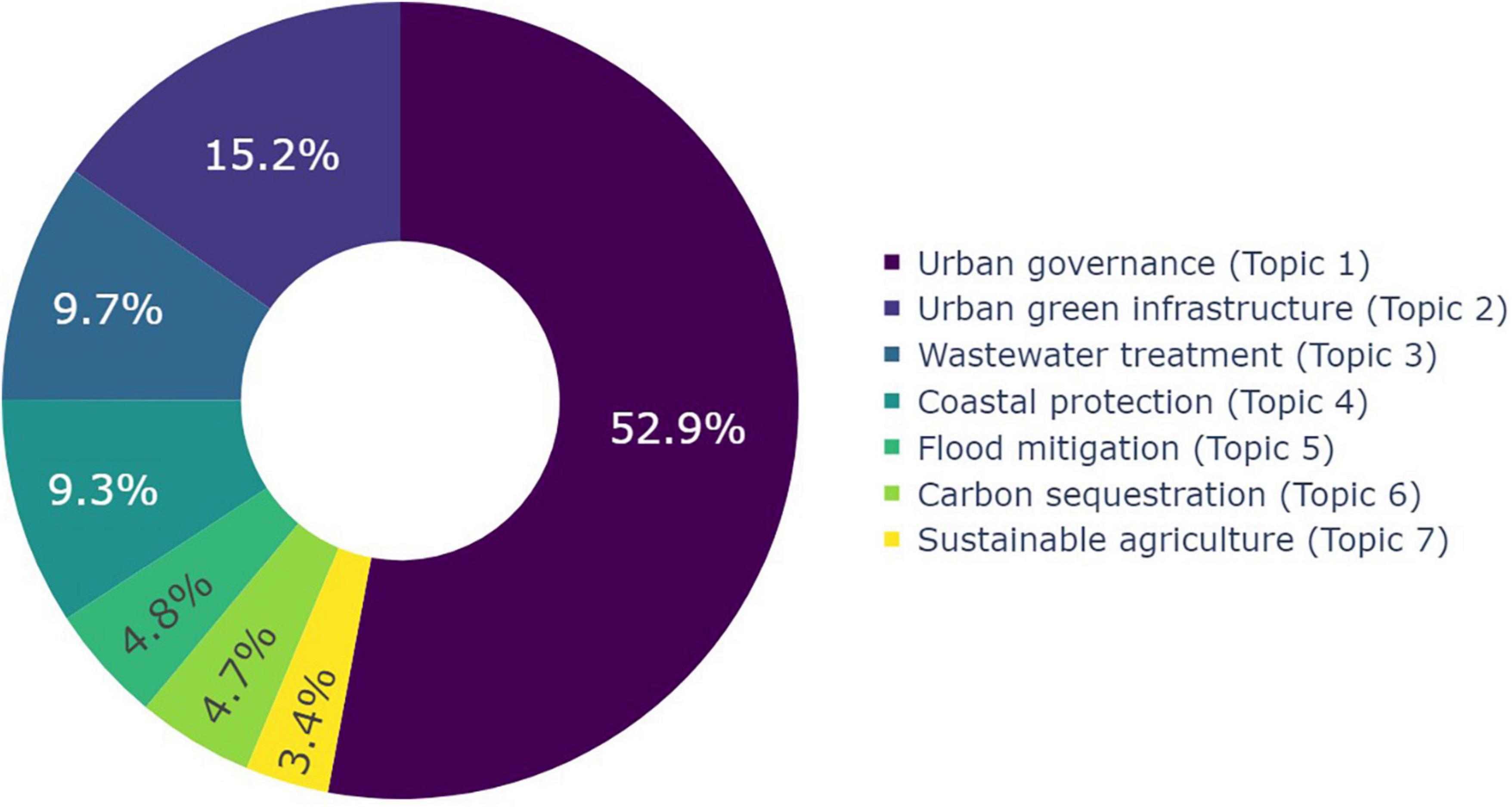
Figure 5. Proportion of topics classified by latent Dirichlet allocation (LDA) topic modeling for the research on nature-based solutions from 2009 to 2022.
3.1.4 Temporal change of topics
Figure 6 shows the trend of each topic’s number of articles (i.e., topic frequency) over time. All topics significantly increased over time (all p < 0.05; Table 2) while showing different patterns with each other. First, Topic 1 (Urban governance), accounting for more than half of the total, rapidly increased at an overwhelmingly large rate compared to other topics since 2016. Topic 2 (Urban green infrastructure) also showed a relatively large increase during the same period. Topic 3 (Wastewater treatment) and Topic 4 (Coastal protection) presented similar growth rates, although their rankings changed several times. The increase rate of Topic 5 (Flooding mitigation) took the ranking after Topic 3 and Topic 4 until 2020, but since 2021, the ranking was overtaken by the growth rate of Topic 6 (Carbon sequestration). The increase rate of Topic 6 was greater than water-related topics such as Topic 3, 4, and 5 since 2021. Finally, Topic 7 (Sustainable agriculture) continuously showed the smallest increase rate over the observation period.
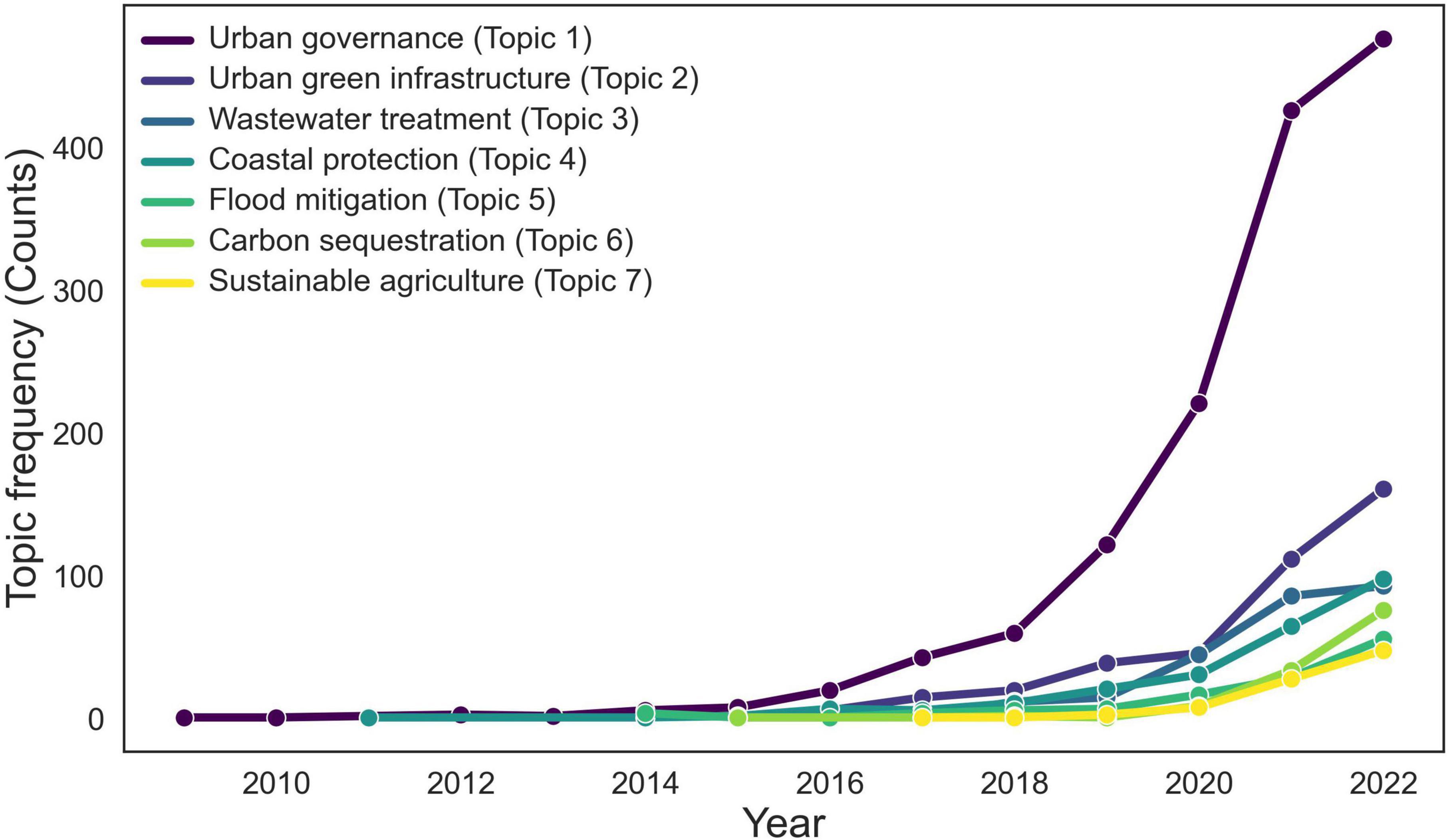
Figure 6. Number of papers of each topic (i.e., topic frequency) classified by latent Dirichlet allocation (LDA) topic modeling from 2009 to 2022.

Table 2. Regression coefficients and p-values of topic frequency and topic proportion classified by latent Dirichlet allocation (LDA) topic modeling from 2017 to 2022.
Figure 7 indicates the temporal trend of the proportion of articles of each topic (i.e., topic proportion) among all research papers. As for the analysis of the temporal trend since 2017, when all topics began to appear simultaneously to 2022, the proportions of Topic 1 (Urban governance) and Topic 2 (Urban green infrastructure) decreased (60%→47% and 21%→16%, respectively) but this was not statistically significant. Topic 3 (Wastewater treatment), Topic 4 (Coastal protection), and Topic 5 (Flooding mitigation) showed temporal variations but did not indicate statistically significant fluctuations. On the other hand, the proportions of Topic 6 (Carbon sequestration) and Topic 7 (Sustainable agriculture) increased significantly (1%→8% and 1%→5%, respectively, and both of them are p < 0.05; Table 2).
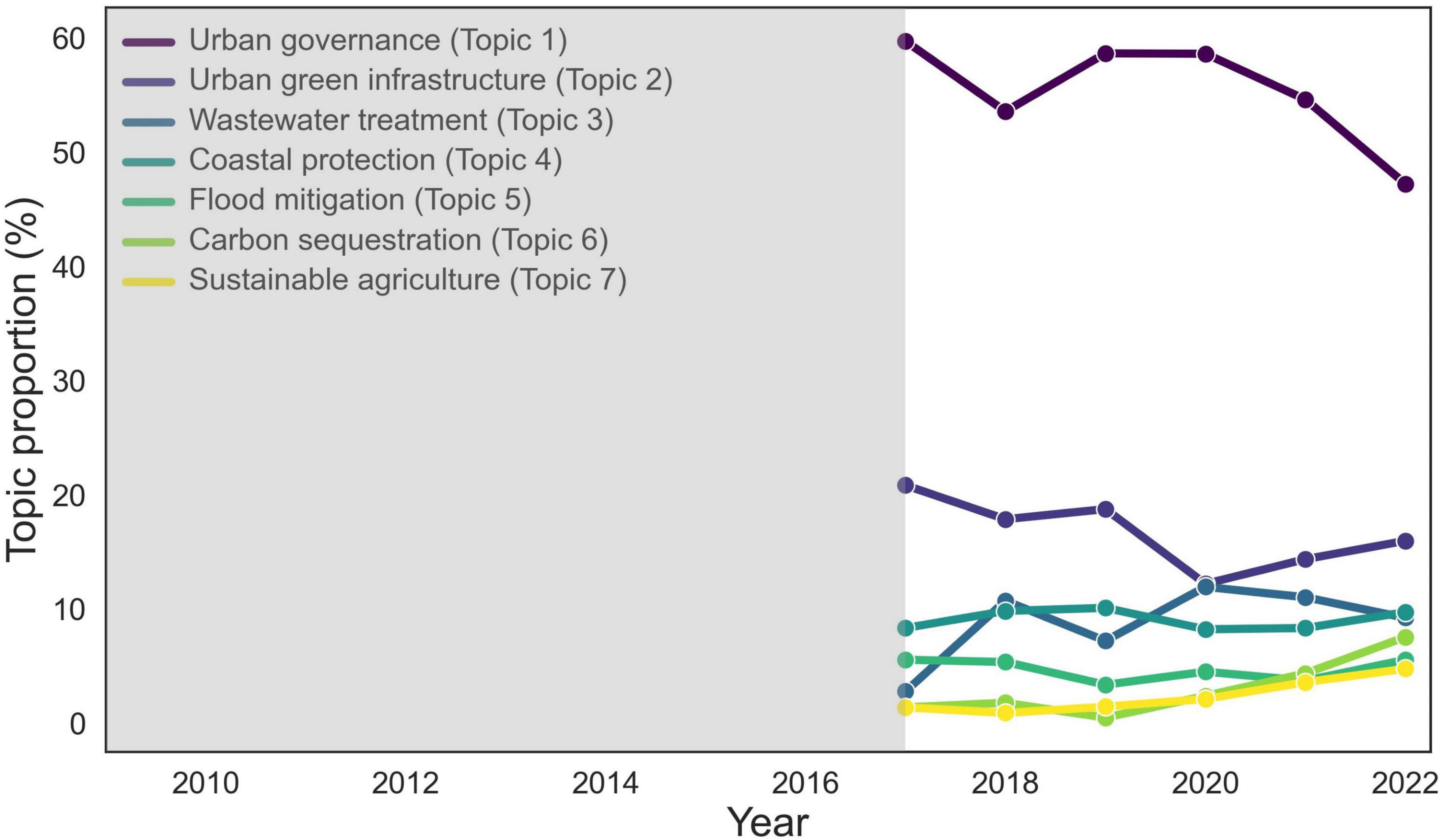
Figure 7. The ratio of the number of papers of each topic over the total number of papers (i.e., topic proportion) classified by latent Dirichlet allocation (LDA) topic modeling from 2017 to 2022.
3.2 Keyword analysis
3.2.1 Keyword frequency
In general, the frequency of all keywords significantly increased from the first period (2017–2018), the second period (2019–2020), and the third period (2021–2022), reflecting the steady increase in research papers on NbS (Table 3).
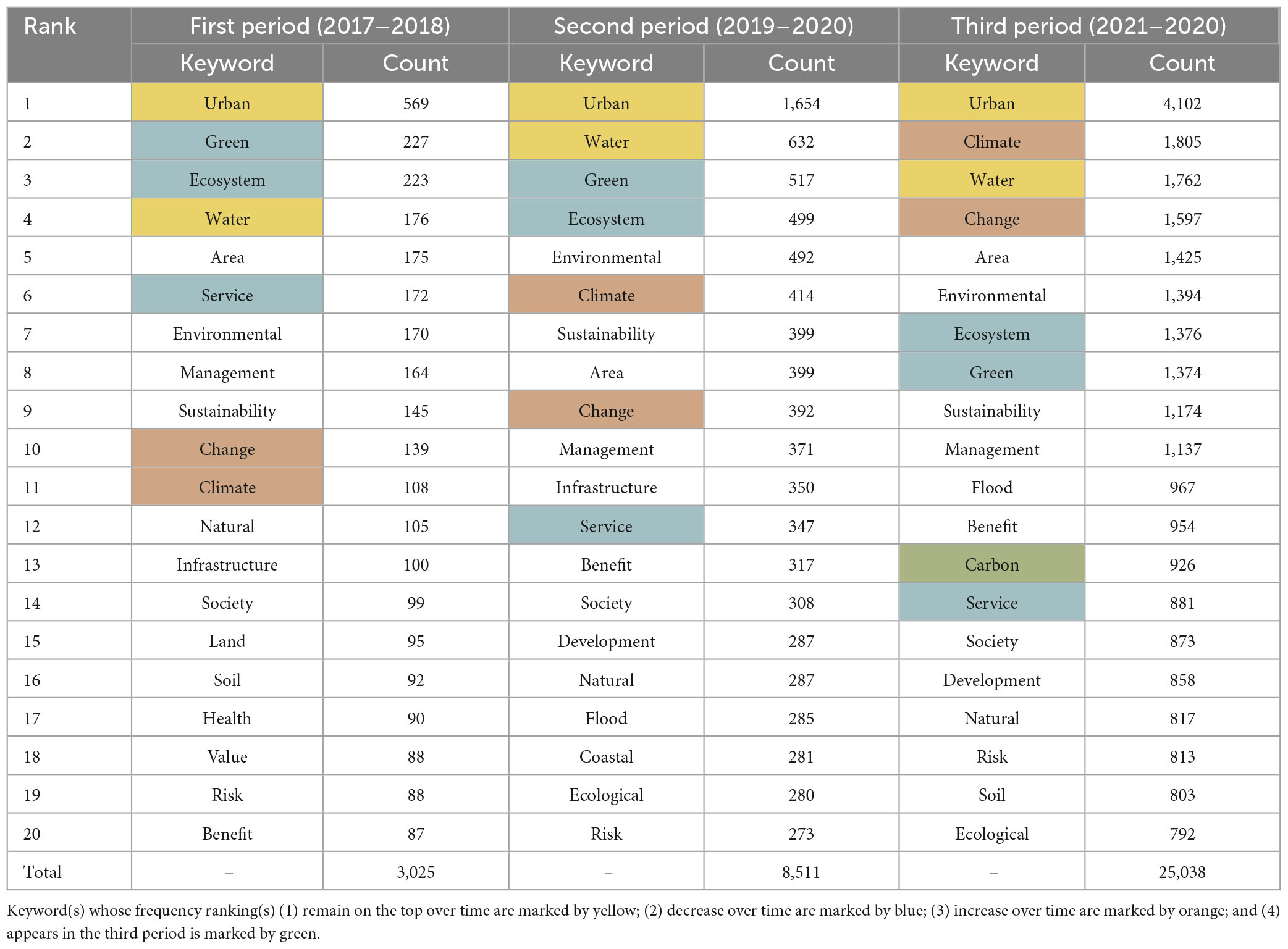
Table 3. Keyword frequency during the first period (2017–2018), second period (2019–2020), and third period (2021–2022).
When comparing the ranking of keywords per period, urban showed the highest frequency among all keywords during those periods and continuously ranked first. The keywords green and ecosystem ranked high (2nd–3rd) in the first period, but their rankings dropped to 7th–8th over time. The keyword service also steadily dropped in ranking from the 6th to the 14th. Meanwhile, the keyword water remained consistently high within the top four. It is important to note that the keywords, such as climate and change, were ranked between 10th and 11th in the first period, and their rankings became higher over time, taking the 2nd and 4th places, respectively, in the third period. The keyword carbon appeared within the top 20 in the third period. Other keywords appeared and disappeared from the rankings, but most maintained similar rankings.
3.2.2 Keyword network
To analyze the keyword network, the size of the nodes was expressed with (1) the degree centrality and (2) the betweenness centrality of keywords. As mentioned earlier, degree centrality increases when a keyword has many direct links to other keywords, while betweenness centrality increases when a keyword frequently appears on the shortest path between two different keywords in the network (Freeman, 1979; Freeman et al., 1991). In both networks, the thickness of links became stronger as the co-occurrence frequency of the connected keyword pair increased. The evolutions of keyword networks were also compared by dividing the periods starting in 2017 by 2 years.
In the network based on degree centrality, the node sizes of keywords became increasingly similar over time, and various links became thicker (Figure 8). In the first period, the node size of urban was remarkably larger, while that of other keywords was relatively smaller. The thick links were mostly connected to urban (e.g., urban-area, urban-water, urban-green, urban-climate, and urban-infrastructure), whereas the rest were thinner. During the second period, the node size of urban was still larger than other nodes, although it was less than in the first period, followed by water. Compared to the first period, the links connected to urban and those not connected to urban became thicker. The third period showed more remarkable changes than the first two periods; the node size of urban became smaller, whereas that of other keywords became larger to a level similar to that of urban. The links connected to urban and other links (e.g., carbon-forest, climate-climate, and flood-risk) became thicker. In summary, compared to the first two periods, when urban had the strongest influence in terms of degree centrality and co-occurrence frequency, the third period saw that the degree centrality of urban decreased, whereas that of other keywords became larger. The co-occurrence frequency pairs appeared diversely. Especially in the third period, the degree centrality of climate and change significantly increased, and simultaneously, that of carbon appeared in the rankings, and that of forest reappeared in the rankings (Table 4). In general, the frequency of all keywords significantly increased from the first period (2017–2018), the second period (2019–2020), and the third period (2021–2022), reflecting the steady increase in research papers on NbS.
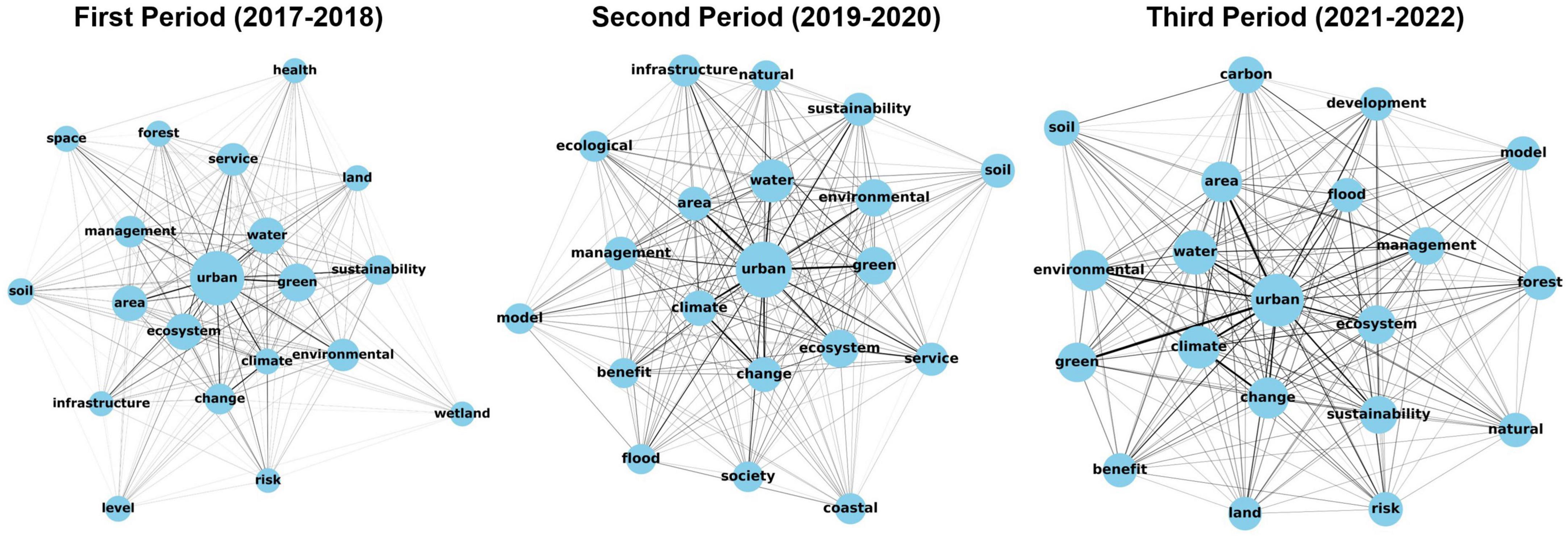
Figure 8. Keyword network based on degree centrality from first period to third period. The node’s size represents the degree of centrality’s magnitude, and the link’s thickness represents the frequency of co-occurrence between keywords.
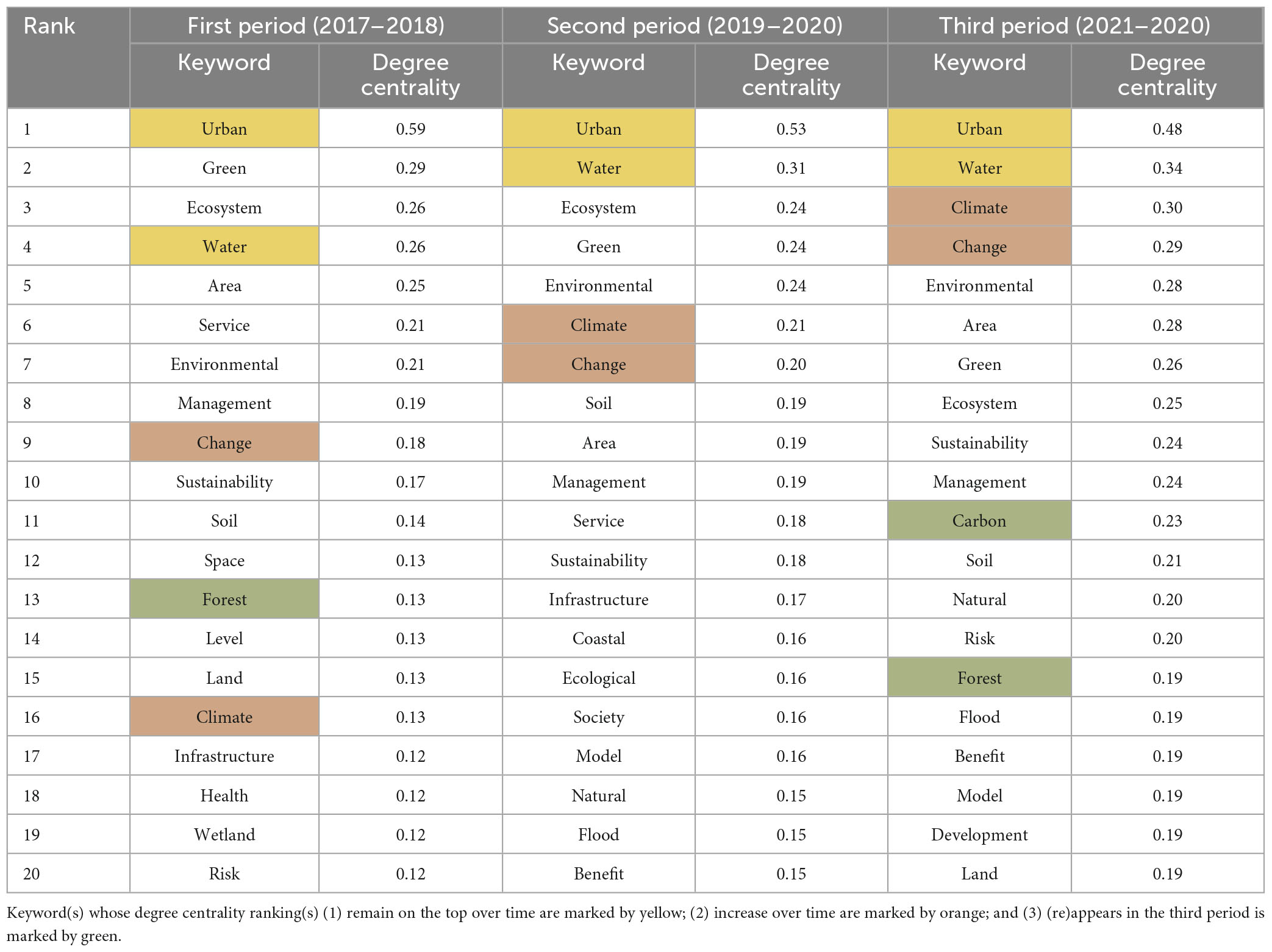
Table 4. Degree centrality during the first period (2017–2018), second period (2019–2020), and third period (2021–2022).
In the network based on betweenness centrality, the same phenomenon was found: the node size concentrated in urban decreased over time, the node of water had the next highest size, and various links became thicker over time (Figure 9). However, unlike the results for degree centrality, the betweenness centrality of most of the keywords did not increase. Only the betweenness centrality of carbon and climate considerably increased over time. Another difference is that soil was ranked high regarding betweenness centrality during the entire period (Table 5).
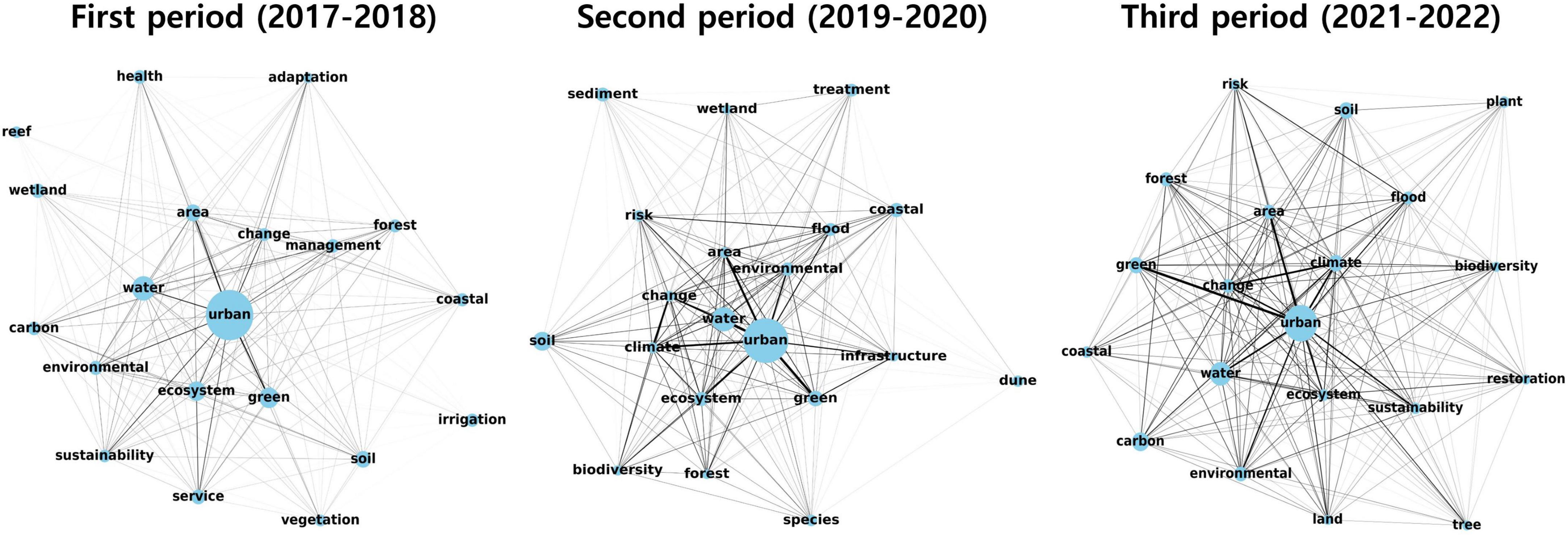
Figure 9. Keyword network based on betweenness centrality from first period to third period. The node’s size represents the degree of centrality’s magnitude, and the link’s thickness represents the frequency of co-occurrence between keywords.
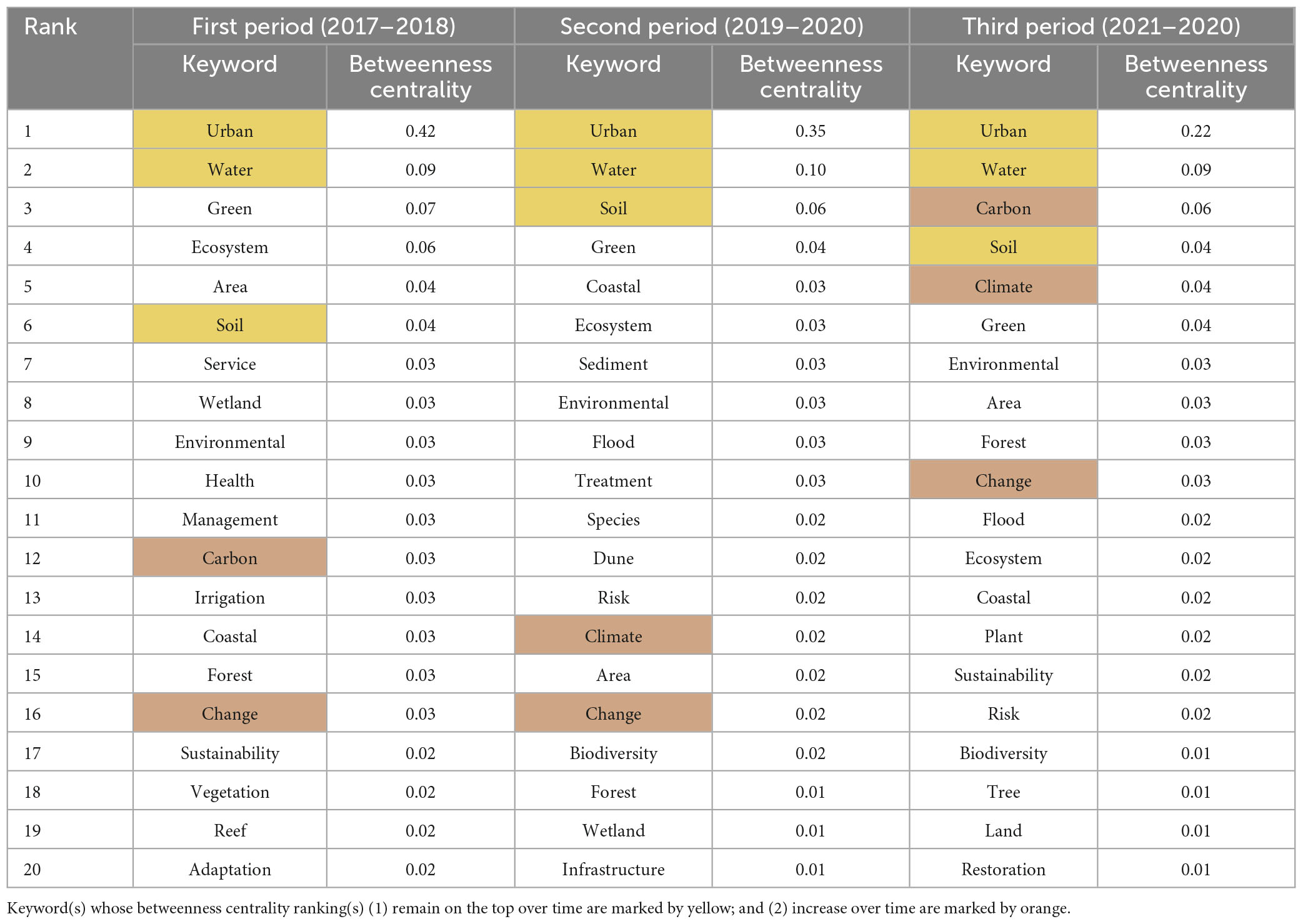
Table 5. Betweenness centrality during the first period (2017–2018), second period (2019–2020), and third period (2021–2022).
4 Discussion
As a result of analyzing research trends while targeting articles published since the term NbS was first officially utilized, it was possible to examine which research has received attention and which research topic is likely to be more studied in the near future. This study also found that when topic modeling and keyword analysis were performed on the same literature dataset, two results delivered a consistent message and could complement each other.
4.1 Trends of topics: big urban and water, small but increasing carbon and agriculture
Since the first appearance of the NbS term, most research has focused on cities (Topic 1, 2) and water (Topic 3, 4, 5) (Figures 5, 6). Still, this study found a significant increase in the proportions of carbon sequestration research (Topic 6) and sustainable agriculture research (Topic 7) recently, with larger increases (Figure 7). The increase in the proportion of carbon sequestration research became larger than the increase in water research between 2021 and 2022. If the former research maintains the same tendency as now, it is expected to overtake the proportion of water-related topics in the near future. The findings of this study suggest that urban and water-related research has been overwhelmingly dominant in the NbS research. Still, despite being less common, carbon sequestration and sustainable agriculture research has increased significantly and may become more active soon.
The findings of this study are consistent with those of other studies that partially examined research trends in NbS. For example, Parker et al. (2020) conducted a quantitative literature review on NbS. They found that NbS was initially studied in traditional research fields such as ecosystem management; however, recently, it was more likely to serve as a specific mechanism in response to climate change. Su et al. (2023) emphasized that ecosystem services, climate change, and sustainability have recently been intensively studied in the NbS research on urban wastewater management, which was clarified by a bibliographic literature review. However, neither study could specifically explain what proportion each field accounts for and how it changes over time, while this study provided a quantitative ground for their arguments by showing increases in the proportions of carbon sequestration and sustainable agriculture among NbS research areas through topic modeling.
4.2 Trends of keyword: more diverse keywords have been appeared beyond urban
As a result of the keyword analysis, as for the keyword frequency, urban was the most frequent keyword during the periods, but the frequency of diverse keywords increased over time; particularly, the frequency of climate and carbon remarkably increased. On the other hand, as for the network based on co-occurrence frequency, (1) in the case of degree centrality, during the first period, the node size of urban was large, but that of other keywords was small, and thick links were mostly connected to urban. However, as we moved on to the third period, the node size of urban became smaller, whereas that of other keywords became larger (especially climate and change), and links between various keywords became thicker (Figure 8). These results imply that the co-occurrence frequency of keywords including not only urban but also climate, change, carbon, and forest became higher over time, and there has been more interest in various fields (particularly climate change) rather than just limiting to the previously dominant urban field. (2) In the case of betweenness centrality, the results were similar to degree centrality, with urban being the highest in all periods. Still, there are differences in that the node size of urban decreased, whereas that of other keywords did not increase, except for such keywords as carbon and climate. There was another difference in the consistently high ranking of soil after water (Figure 9). These outcomes indicate that keywords such as urban, water, and soil have been consistently important in mediating the shortest distance between different keywords, and the role of carbon and climate has become relatively more important over time.
This tendency in which the frequency of carbon or climate increases, or the connection with other keywords becomes dense in the NbS research, is a new result that has never been reported in previous studies. For example, Nyika and Dinka (2022) analyzed keywords in NbS articles targeting Africa over the past decade and found that climate change most frequently appeared along with conservation, governance, and South Africa. There were close connections with other keywords, but they could not show whether there was an increasing trend, as they did not make a comparison per period. Mendes et al. (2020) also analyzed the keywords from 132 articles on NbS and found that climate change had the highest connection with NbS, after ecosystem service, but could not show an increasing trend over time.
As shown in this study, the findings that the frequency of carbon or climate increased over time, and the connections with other keywords also increased, reflect the current situation in which there has been a growing interest in NbS in the last decade as a means to reduce GHGs causing climate change (Seddon et al., 2020). Furthermore, Nationally Determined Contributions (NDC), which are GHGs reduction targets that were voluntarily set by each country to meet the goals of the Paris Agreement and were applied after 2020, have become more important. As the most NDCs recognized NbS as a means to mitigate and adapt to climate change impacts (Seddon et al., 2019), it can be assumed that NbS has recently become solidified its position as a means to reduce GHGs.
4.3 Limitations and lessons-learned from this study
The two (i.e., topical modeling and keyword analysis) methods used in this study have their own limitations. First, topic modeling assumes that one research paper has only one topic, which is not always true. For example, restoring mangrove forests along the coast could prevent coastal erosion but could also be interpreted as mitigating GHGs by sequestering carbon. However, topic modeling cannot handle the multifunctional features of NbS research, which may cover more than two topics, because each article was assigned to only one topic with the highest probability of being assigned. Instead, by assigning articles to the corresponding topic, it makes it possible to calculate the proportion of the corresponding topic in the entire research. On the other hand, keyword analysis can reflect the multifunctional phenomenon of simultaneously using multiple keywords in a single paper by analyzing the frequency of keywords or the co-occurrence frequency of keyword pairs. Still, it is difficult to analyze the results by matching the number of papers.
To compensate for the limitations of each method, this study both analyzed how the number of articles corresponding to each topic changed over time at a topic level using topic modeling and analyzed how the frequency and co-occurrence frequency of each keyword changed over time at a keyword level using keyword analysis. As a result, those two methods, with approaches to NbS research at topic and keyword levels, conveyed a consistent message that there has been an increase in recent interest in carbon and climate change. Therefore, this study confirmed that these two methods are complementary while bringing more confidence in the findings of this study.
However, as increased academic research on carbon or climate in NbS does not always guarantee success in policies (e.g., Seddon et al., 2021; Viti et al., 2022). Beyond the academic realm, in which there have been more studies on NbS to respond to climate change, there should be political and technical support to contribute to solving climate change issues practically in reality. To this end, it will be necessary to increase the value of NbS in mainstreaming climate change policy and the application and effectiveness of climate technology. Additionally, since NbS is multifunctional and interdisciplinary, it should be researched as a Nexus between climate change and other areas (e.g., city, water, and food).
5 Conclusion
This study quantitatively analyzed the global research trends in NbS over the last 13 years through topic modeling and keyword analysis. Such attempts helped to understand how NbS has been promoted in which fields to address social issues. This study confirmed that NbS has been researched in governance and infrastructure building to solve urban issues, various measures to solve water problems such as wastewater, coastal erosion, flooding, carbon sequestration to address climate change, and agriculture for sustainable coexistence with biodiversity. While NbS has been mainly focused on solving urban and water-related issues, it has been gradually expanding to other fields based on the connections with NbS; especially, carbon sequestration in response to climate change was confirmed to be the fastest-growing field. These results imply that carbon sequestration and responses to climate change will be more researched in NbS in the near future. Additionally, this result confirmed that topic modeling and keyword analysis, which have limitations when used individually, are complementary to each other when used together.
Data availability statement
The raw data supporting the conclusions of this article will be made available by the authors, without undue reservation.
Author contributions
HY: Conceptualization, Investigation, Methodology, Validation, Visualization, Writing – original draft, Writing – review & editing. JC: Data curation, Investigation, Methodology, Software, Validation, Visualization, Writing – original draft, Writing – review & editing. CS: Writing – original draft, Writing – review & editing. EC: Conceptualization, Funding acquisition, Project administration, Resources, Supervision, Writing – original draft, Writing – review & editing.
Funding
The author(s) declare financial support was received for the research, authorship, and/or publication of this article. This work was supported by the National Institute of Forest Science, grant number FM0800-2021-03-2024.
Conflict of interest
The authors declare that the research was conducted in the absence of any commercial or financial relationships that could be construed as a potential conflict of interest.
Publisher’s note
All claims expressed in this article are solely those of the authors and do not necessarily represent those of their affiliated organizations, or those of the publisher, the editors and the reviewers. Any product that may be evaluated in this article, or claim that may be made by its manufacturer, is not guaranteed or endorsed by the publisher.
Supplementary material
The Supplementary Material for this article can be found online at: https://www.frontiersin.org/articles/10.3389/ffgc.2024.1351189/full#supplementary-material
References
Albuquerque, U. P., Ludwig, D., Feitosa, I. S., de Moura, J. M. B., Gonçalves, P. H. S., de Silva, R. H., et al. (2021). Integrating traditional ecological knowledge into academic research at local and global scales. Region. Environ. Change 21, 1–11. doi: 10.1007/s10113-021-01774-2
Alves, F. M., Gonçalves, A., and del Caz-Enjuto, M. R. (2022). The use of envi-met for the assessment of nature-based solutions’ potentiae3l benefits in industrial parks–a case study of Argales industrial park (Valladolid, Spain). Infrastructures 7:85. doi: 10.3390/infrastructures7060085
Arslan, M., and El-Din, M. G. (2021). Bacterial diversity in petroleum coke based biofilters treating oil sands process water. Sci. Total Environ. 782:146742. doi: 10.1016/j.scitotenv.2021.146742
Barron, N. J., Hatt, B., Jung, J., Chen, Y., and Deletic, A. (2020). Seasonal operation of dual-mode biofilters: The influence of plant species on stormwater and greywater treatment. Sci. Total Environ. 715:136680. doi: 10.1016/j.scitotenv.2020.136680
Beceiro, P., Galvão, A., and Brito, R. S. (2020). Resilience assessment framework for nature based solutions in stormwater management and control: Application to cities with different resilience maturity. Sustainability 12:10040. doi: 10.3390/su122310040
Berkes, F., Colding, J., and Folke, C. (2000). Rediscovery of traditional ecological knowledge as adaptive management. Ecol. Appl. 10, 1251–1262. doi: 10.2307/2641280
Bianciardi, A., Becattini, N., and Cascini, G. (2023). How would nature design and implement nature-based solutions. Nat. Based Solut. 3:100047. doi: 10.1016/j.nbsj.2022.100047
Bokhove, O., Kelmanson, M. A., Kent, T., Piton, G., and Tacnet, J. M. (2019). Communicating (nature-based) flood-mitigation schemes using flood-excess volume. River Res. Appl. 35, 1402–1414. doi: 10.1002/rra.3507
Cambrosio, A., Limoges, C., Courtial, J., and Lavile, F. (1993). Historical scientometrics? Mapping over 70 years of biological safety research with coword analysis. Scientometrics 27, 119–143. doi: 10.1007/bf02016546
Castellanos, L. A., Versini, P. A., Bonin, O., and Tchiguirinskaia, I. (2020). A text-mining approach to compare impacts and benefits of nature-based solutions in Europe. Sustainability 12:7799. doi: 10.3390/su12187799
Catarino, R., Bretagnolle, V., Perrot, T., Vialloux, F., and Gaba, S. (2019). Bee pollination outperforms pesticides for oilseed crop production and profitability. Proc. R. Soc. B Biol. Sci. 286:20191550. doi: 10.1098/rspb.2019.1550
Cavazzoli, S., Selonen, V., Rantalainen, A. L., Sinkkonen, A., Romantschuk, M., and Squartini, A. (2022). Natural additives contribute to hydrocarbon and heavy metal co-contaminated soil remediation. Environ. Pollut. 307:119569. doi: 10.1016/j.envpol.2022.119569
Chang, J., Gerrish, S., Wang, C., Boyd-Graber, J., and Blei, D. (2009). “Reading tea leaves: How humans interpret topic models,” in Proceedings of the neural information processing systems, eds Y. Bengio, D. Schuurmans, J. Lafferty, C. Williams, and A. Culotta (San Mateo, CA), 288–296.
Choi, E., Kim, R., Chae, J., Yang, A., Jang, E., and Lee, K. Y. (2023). Analysis of nature-based solutions research trends and integrated means of implementation in climate change. Atmosphere 14:1775. doi: 10.3390/atmos14121775
Chowdhury, M. S. N., Walles, B., Sharifuzzaman, S. M., Shahadat Hossain, M., Ysebaert, T., and Smal, A. C. (2019). Oyster breakwater reefs promote adjacent mudflat stability and salt marsh growth in a monsoon dominated subtropical coast. Sci. Rep. 9:8549. doi: 10.1038/s41598-019-44925-6
Cohen-Shacham, E., Walters, G., Janzen, C., and Maginnis, S. (2016). Nature-based Solutions to address global societal challenges. International union for conservation of nature. Gland: IUCN, doi: 10.2305/IUCN.CH.2016.13.en
Ding, Y., Chowdhury, G. G., and Foo, S. (2001). Bibliometric cartography of information retrieval research by using co-word analysis. Inform. Process. Manag. 37, 817–842. doi: 10.1016/S0306-4573(00)00051-0
Du, C., Jia, W., Chen, M., Yan, L., and Wang, K. (2022). How can urban parks be planned to maximize cooling effect in hot extremes? Linking maximum and accumulative perspectives. J. Environ. Manag. 317:115346. doi: 10.1016/j.jenvman.2022.115346
Eichmanns, C., and Schüttrumpf, H. (2020). Investigating changes in aeolian sediment transport at coastal dunes and sand trapping fences: A field study on the German coast. J. Marine Sci. Eng. 8:1012. doi: 10.3390/jmse8121012
Elias, F., Ferreria, J., Resende, A. F., Berenguer, E., França, F., Smith, C. C., et al. (2022). Comparing contemporary and lifetime rates of carbon accumulation from secondary forests in the eastern Amazon. Forest Ecol. Manag. 508:120053. doi: 10.1016/j.foreco.2022.120053
European Commission [EC] (2023). Nature-based solutions. European Commission. Brussels: European Commission [EC].
Federal Ministry for the Environment, Nature Conservation, Nuclear Safety and Consumer Protection (BMUV) (2023). Federal action plan on nature-based solutions for climate and biodiversity. Berlin: BMUV printing office.
Freeman, L. C. (1979). Centrality in social networks: Conceptual classification. Soc. Netw. 1, 215–339. doi: 10.1016/0378-8733(78)90021-7
Freeman, L. C., Borgatti, S. P., and White, D. R. (1991). Centrality in valued graphs: A measure of betweenness based on network flow. Soc. Netw. 13, 141–154. doi: 10.1016/0378-8733(91)90017-N
Fuller, M., and Dwivedi, P. (2021). The cost of carbon stored on afforested lands in the southern United States. Trees Forests People 6:100129. doi: 10.1016/j.tfp.2021.100129
Gallagher, A. J., Brownscombe, J. W., Alsudairy, N. A., Casagrande, A. B., Fu, C., Harding, L., et al. (2022). Tiger sharks support the characterization of the world’s largest seagrass ecosystem. Nature Commun. 13:6328. doi: 10.1038/s41467-022-33926-1
Greene, D., and Cross, J. P. (2017). Exploring the political agenda of the European Parliament using a dynamic topic modeling approach. Politic. Anal. 25, 77–94. doi: 10.1017/pan.2016.7
Gunn, E. L., Rica, M., Zorrilla-Miras, P., Vay, L., Mayor, B., Pagano, A., et al. (2021). The natural assurance value of nature-based solutions: A layered institutional analysis of socio ecological systems for long term climate resilient transformation. Ecol. Econ. 186:107053. doi: 10.1016/j.ecolecon.2021.107053
Hardoy, J., Motta, J. M., Kozak, D., Almansi, F., Reverter, T., and Costello, M. (2022). Exploring the links between the use of NbS, mindshifts and transformative urban coalitions to promote climate resilience within an ongoing reurbanization process. The case of Villa 20, Buenos Aries. Front. Sustain. Cities 4:962168. doi: 10.3389/frsc.2022.962168
Intergovernmental Panel on Climate Change [IPCC] (2022). “Climate change 2022: Impacts, adaptation and vulnerability,” in Proceedings of the contribution of working group ii to the 6th assessment report of the intergovernmental panel on climate change, eds H.-O. Pörtner, D. C. Roberts, M. Tignor, E. S. Poloczanska, K. Mintenbeck, A. Alegría, et al. (New York, NY), 87. doi: 10.1017/9781009325844
Intergovernmental Science-Policy Platform on Biodiversity and Ecosystem Services [IPBES] (2019). in Summary for policymakers of the global assessment report on biodiversity and ecosystem services of the intergovernmental science-policy platform on biodiversity and ecosystem services, eds S. Díaz, J. Settele, E. S. Brondízio, H. T. Ngo, M. Guèze, J. Agard, et al. (Bonn: IPBES secretariat), 18. doi: 10.5281/zenodo.3553579
James, R. K., Lynch, A., Herman, P. M. J., van Katwijk, M. M., van Tussenbroek, B. I., Dijkstra, H. A., et al. (2020). Tropical biogeomorphic seagrass landscapes for coastal protection: Persistence and wave attenuation during major storms events. Ecosystems 24, 301–318. doi: 10.1007/s10021-020-00519-2
Karuri, H. (2022). Root and soil health management approaches for control of plant-parasitic nematodes in sub-Saharan Africa. Crop Protect. 152:105841. doi: 10.1016/j.cropro.2021.105841
Kherwa, P., and Bansal, P. (2019). Topic modeling: A comprehensive review. EAI Endorsed Trans. Scalable Inform. Syst. 7:e2. doi: 10.4108/eai.13-7-2018.159623
Le Gouvello, R., Cohen-Shacham, E., Herr, D., Spadone, A., Simard, F., and Brugere, C. (2023). The IUCN global standard for nature-based solutions™ as a tool for enhancing the sustainable development of marine aquaculture. Front. Marine Sci. 10:1146637. doi: 10.3389/fmars.2023.1146637
Lee, S. S. (2014). A content analysis of journal articles using the language network analysis methods. J. Korean Soc. Inform. Manag. 31, 49–68. doi: 10.3743/KOSIM.2014.31.4.049
MacKinnon, Sobrevila, K., Hickey, C., and Valerie. (2008). Biodiversity, climate change and adaption: Nature-based solutions from the World Bank portfolio. Washington, DC: World Bank Group.
Mahmoud, I. H., Morello, E., Vona, C., Benciolini, M., Sejdullahu, I., Trentin, M., et al. (2021). Setting the social monitoring framework for nature-based solution impact: Methodological approach and pre-greening measurements in the case study from CLEVER cities Milan. Sustainability 13:9672. doi: 10.3390/su13179672
Matthews, H. D., Zickfeld, K., Dickau, M., Marclsaac, A. J., Mathesius, S., Nzotungicimpaye, C. M., et al. (2022). Temporary nature-based carbon removal can lower peak warming in a well-below 2°C scenario. Commun. Earth Environ. 3:65. doi: 10.1038/s43247-022-00391-z
Mendes, R., Fidélis, T., Roebeling, P., and Teles, F. (2020). The institutionalization of nature-based solutions–a discourse analysis of emergent literature. Resources 9:6. doi: 10.3390/resources9010006
Montenegro, I. P. F. M., Mucha, A. P., Tomasino, M. P., Gomes, C. R., and Almeida, C. M. R. (2021). Alkylphenols and chlorophenols remediation in vertical flow constructed wetlands: Removal efficiency and microbial community response. Water 13:715. doi: 10.3390/w13050715
Nastran, M., Kobal, M., and Eler, K. (2019). Urban heat islands in relation to green land use in European cities. Urban Forestry Urban Green. 37, 33–41. doi: 10.1016/j.ufug.2018.01.008
Nyika, J., and Dinka, M. O. (2022). Integrated approaches to nature-based solutions in Africa: Insights from a bibliometric analysis. Nat. Based Solut. 2:100031. doi: 10.1016/j.nbsj.2022.100031
Parker, J., Simpson, G. D., and Miller, J. E. (2020). Nature-based solutions forming urban intervention approaches to anthropogenic climate change: A quantitative literature review. Sustainability 12:7439. doi: 10.3390/su12187439
Perrot, T., Bretagnolle, V., and Gaba, S. (2022). Environmentally friendly landscape management improves oilseed rape yields by increasing pollinators and reducing pests. J. Appl. Ecol. 59, 1825–1836. doi: 10.1111/1365-2664.14190
Pettorelli, N., Graham, N. A. J., Seddon, N., Bustamante, M. M. C., Lowton, M. J., Sutherland, W. J., et al. (2021). Time to integrate global climate change and biodiversity science-policy agendas. J. Appl. Ecol. 58, 2384–2393. doi: 10.1111/1365-2664.13985
Reynolds, C. C., Escobedo, F. J., Clerici, N., and Zea-Camaño, J. (2017). Does “greening” of neotropical cities considerably mitigate carbon dioxide emissions? The case of Medellin, Colombia. Sustainability 9:785. doi: 10.3390/su9050785
Röder, M., Both, A., and Hinneburg, A. (2015). “Exploring the space of topic coherence measures,” in Proceedings of the 8hth ACM international conference on web search and data mining (WSDM ’15), (New York, NY: ACM), 399–408. doi: 10.1145/2684822.2685324
Satori, D., Tovar, C., Faruk, A., Hunt, E. H., Muller, G., Cockel, C., et al. (2021). Prioritising crop wild relatives to enhance agricultural resilience in sub-Saharan Africa under climate change. Plants People Planet 4, 269–282. doi: 10.1002/ppp3.10247
Seddon, N., Chausson, A., Berry, P., Girardin, C. A. J., Smith, A., and Turner, B. (2020). Understanding the value and limits of nature-based solutions to climate change and other global challenges. Philos. Trans. R. Soc. B 375:20190120. doi: 10.1098/rstb.2019.0120
Seddon, N., Sengupta, S., García-Espinosa, M., Hauler, I., Herr, D., and Rizvi, A. R. (2019). Nature-based solutions in nationally determined contributions: Synthesis and recommendations for enhancing climate ambition and action by 2020. Oxford: IUCN and University of Oxford.
Seddon, N., Smith, A., Smith, P., Key, I., Chausson, A., Girardin, C., et al. (2021). Getting the message right on nature-based solutions to climate change. Glob. Change Biol. 27, 1518–1546. doi: 10.1111/gcb.15513
Strack, M., Davidson, S. J., Hirano, T., and Dunn, C. (2022). The potential of peatlands as nature-based climate solutions. Curr. Clim. Change Rep. 8, 71–82. doi: 10.1007/s40641-022-00183-9
Su, J., Wang, M., Razi, M. A. M., Dom, N. M., Sulaiman, N., and Tan, L. W. (2023). A bibliometric review of nature-based solutions on urban stormwater management. Sustainability 15:7281. doi: 10.3390/su15097281
Subbarao, G. V., Kishii, M., Bozal-Leorri, A., Ortiz-Monasterio, I., Gao, X., Ibba, M. I., et al. (2021). Enlisting wild grass genes to combat nitrification in wheat farming: A nature-based solution. Agric. Sci. 118:e2106595118. doi: 10.1073/pnas.2106595118
Tseng, L. H., Vojinovic, Z., Wu, M. H., Doong, D. J., and Lo, W. C. (2022). “Modeling nature-based solutions with quasi-2D model,” in Advances in hydroinformatics, eds P. Gourbesville and G. Caignaert (Cham: Springer), 605–613. doi: 10.1007/978-981-19-1600-7_38
Ungvári, G., and Kis, A. (2022). Reducing flood risk by effective use of flood-peak polders: A case study of the Tisza River. J. Flood Risk Manag. 15:e12823. doi: 10.1111/jfr3.12823
Valkó,, O., Rádai, Z., and Deák, B. (2022). Hay transfer is a nature-based and sustainable solution for restoring grassland biodiversity. J. Environ. Manag. 311:114816. doi: 10.1016/j.jenvman.2022.114816
van Veelen, T., Karunarathna, H., and Reeve, D. E. (2021). Modelling wave attenuation by quasi-flexible coastal vegetation. Coast. Eng. 164:103820. doi: 10.1016/j.coastaleng.2020.103820
Vayansky, I., and Kumar, S. A. P. (2020). A review of topic modeling methods. Inform. Syst. 94:101582. doi: 10.1016/j.is.2020.101582
Viti, M., Löwe, R., Sørup, H. J. D., Rasmussen, M., Arnbjerg-Nielsen, K., and McKnight, U. S. (2022). Knowledge gaps and future research needs for assessing the non-market benefits of Nature-Based Solutions and Nature-Based Solution-like strategies. Sci. Total. Environ. 841:156636. doi: 10.1016/j.scitotenv.2022.156636
Wamsler, C., Osberg, G., Panagiotou, A., Smith, B., Stanbridge, P., Osika, W., et al. (2023). Meaning-making in a context of climate change: Supporting agency and political engagement. Clim. Policy 23, 829–844. doi: 10.1080/14693062.2022.2121254
Wu, Y., Sun, J., Xu, Y. J., Zhang, G., and Liu, T. (2022). Projection of future hydrometeorological extremes and wetland flood mitigation services with different global warming levels: A case study in the Nenjiang river basin. Ecol. Indicat. 140:108987. doi: 10.1016/j.ecolind.2022.108987
Wu, Y., Zhang, G., Rousseau, A. N., Xu, Y. J., and Foulon, É (2020). On how wetlands can provide flood resilience in a large river basin: A case study in Nenjiang river Basin, China. J. Hydrol. 587:125012. doi: 10.1016/j.jhydrol.2020.125012
Xu, C., Rahman, M., Haase, D., Wu, Y., Su, M., and Pauleit, S. (2020). Surface runoff in urban areas: The role of residential cover and urban growth form. J. Clean. Prod. 262:121421. doi: 10.1016/j.jclepro.2020.121421
Yan, E., and Ding, Y. (2009). Applying centrality measures to impact analysis: A coauthorship network analysis. J. Am. Soc. Inform. Sci. Technol. 60, 2107–2118. doi: 10.1002/asi.21128
Yao, F., and Wang, Y. (2020). Tracking urban geo-topics based on dynamic topic model. Comput. Environ. Urban Syst. 79:101419. doi: 10.1016/j.compenvurbsys.2019.101419
Yu, S.-Y., and Lee, J. Y. (2008). Journal citation analysis for library services on interdisciplinary domains: A case study of department of biotechnology, Y university. J. Korean Soc. Inform. Manag. 25, 283–308. doi: 10.3743/KOSIM.2008.25.4.283
Zabret, K., and Šraj, M. (2019). Rainfall interception by urban trees and their impact on potential surface runoff. Clean Soil Air Water 47:1800327. doi: 10.1002/clen.201800327
Zhao, T., and Nepf, H. M. (2021). Turbulence dictates bedload transport in vegetated channels without dependence on stem diameter and arrangement. Geophys. Res. Lett. 48:e2021GL095316. doi: 10.1029/2021GL095316
Keywords: nature-based solution, research trend analysis, topic modeling, keyword analysis, climate change
Citation: Yang H, Chae J, Song C and Choi E (2024) Research trends of nature-based solutions: from urban to climate change. Front. For. Glob. Change 7:1351189. doi: 10.3389/ffgc.2024.1351189
Received: 06 December 2023; Accepted: 30 May 2024;
Published: 14 June 2024.
Edited by:
Cristina Matos, University of Trás-os-Montes and Alto Douro, PortugalReviewed by:
Ana Briga-Sá, University of Trás-os-Montes and Alto Douro, PortugalCristina Maria Monteiro, CBQF/Escola Superior de Biotecnologia – Universidade Católica Portuguesa, Portugal
Copyright © 2024 Yang, Chae, Song and Choi. This is an open-access article distributed under the terms of the Creative Commons Attribution License (CC BY). The use, distribution or reproduction in other forums is permitted, provided the original author(s) and the copyright owner(s) are credited and that the original publication in this journal is cited, in accordance with accepted academic practice. No use, distribution or reproduction is permitted which does not comply with these terms.
*Correspondence: Eunho Choi, ZWhjaG9pNzEwQGtvcmVhLmty
 Hyunyoung Yang
Hyunyoung Yang Jeongyeon Chae1
Jeongyeon Chae1